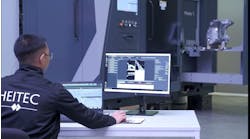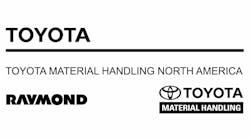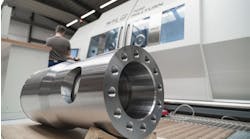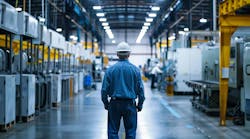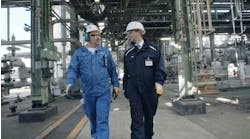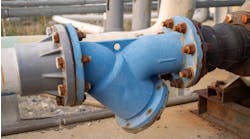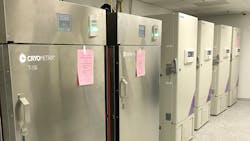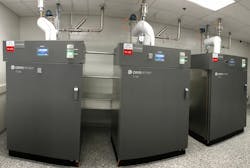Upright Liquid Nitrogen Biorepositories: Safer, More Reliable, and Controllable
In the pharmaceutical and medical industries, cryogenic freezers are used as biorepositories for the long-term preservation of biospecimens such as tissue, blood, plasma or urine. These biorepositories are essentially libraries where biospecimens are stored for clinical or research purposes. Consequently, biorepositories are vital for understanding diseases, genetics, developing prophylactic and therapeutic agents, and monitoring human population health including outcomes related to environmental exposures.
With so much at stake, the failure of a cryogenic freezer to properly maintain biological samples at the required temperatures can be potentially catastrophic and costly. In addition, personnel need to be protected when storing or retrieving samples that are stored at extremely low, cryogenic temperatures.
The challenge is that conventional options for biorepositories—traditional stainless-steel vats, or cryovats, that contain LN2 and compressor-based systems—pose significant disadvantages in terms of safety, reliability, and temperature control.
In response, a new category of upright liquid nitrogen freezers is improving both operator and sample safety, while offering greater reliability, along with adjustable temperatures down to -160°C (-256°F) and faster freeze times.
With this approach, LN2 circulates within the walls of the freezer keeping the contents frozen while preventing direct exposure to users. The units provide the convenience of an upright freezer with good temperature uniformity throughout. The design minimizes the need for maintenance since there are few moving parts and no high-maintenance mechanical compressor.
Overcoming Conventional Cryogenic Freezer Challenges
When using conventional cryovats, there are significant hazards in having any direct contact with LN2 including extremely cold vapor that can rapidly freeze skin tissue and eye fluid, resulting in cold burns, frostbite, and permanent eye damage even through brief exposure.
Since LN2 is liquefied under high pressure, it can expand to a very large volume of gas. Consequently, asphyxiation caused by the vaporization of liquid nitrogen can create oxygen deficiency in the immediate environment and cause unconsciousness, and even death in rare cases. In addition, pressure buildup and explosions can occur without adequate venting or pressure-relief devices that allow cryogen evaporation.
“When cooled below -150°C (-238°F), liquid nitrogen turns into a frigid vapor that keeps the samples frozen. But the liquid nitrogen can be hazardous during loading and unloading when personnel place items into vats of LN2,” says Kim Boyce, President of Reflect Scientific, Inc., an Orem, Utah-based manufacturer that develops and markets innovative, proprietary cryogenic cooling technologies for the biotechnology, pharmaceutical, medical, and transportation markets. The company has more than 30 patents relating to the use of liquid nitrogen with low-temperature freezers, chillers, and refrigerated systems.
Given the risks, liquid nitrogen should be handled only in well-ventilated areas when used with vats indoors, and the LN2 should be handled slowly and carefully to minimize boiling and splashing. Tongs should be used to withdraw objects immersed in the LN2 and personnel should never touch non-insulated vessels containing it. In many cases, personal protective equipment is recommended, as well as extensive training.
Controlling temperature in vats is also difficult, even impossible since there are no safe, reliable means of adjusting the temperature of the LN2 within the vat. Cross-contamination can be an issue within vats as well when multiple samples are stored in the same vicinity.
“Cryovats are basically passive systems that use LN2, where there is really only one temperature,” says Boyce.
Today, modern upright freezer designs address many of these potential safety issues associated with cryovats.
“Upright liquid nitrogen freezers are designed to prevent direct contact with LN2. The liquid nitrogen is self-contained, so there is no exposure to the user or the products,” says Boyce.
In the case of Reflect Scientific’s Cryometrix T-160 Ultra Low Temp Freezer, the unit uses LN2 within but prevents user contact. The upright freezer provides adjustable temperatures from 20 to -160°C (68 to -256°F), which is considerably lower than conventional upright freezer options, enabling significantly faster freeze times. The design also provides temperature uniformity ±7°C throughout, protecting the integrity of all samples within the unit.
At the other end are compressor-based systems that use refrigerants as an essential part of the cooling process cycle. Even though compressor-based systems allow temperature setting, mechanical compressors work constantly and have many moving parts that are susceptible to breakdown.
Consequently, these systems can require significant maintenance and repair while lacking necessary reliability. A wide range of causes can contribute to compressor breakdowns such as electrical failure, insufficient lubrication, blocked condenser coils, and overheating due to dusty coils, low refrigerant levels or inadequate insulation.
“Compressor-based systems can accommodate a wide range of temperatures but need to run 23 out of 24 hours a day and have a lot of moving parts, so they break down and require frequent maintenance,” says Boyce.
The other concern is that compressor-based systems use refrigerants, such as CFCs, which contribute to global warming as extremely potent greenhouse gases and can damage the ozone layer.
In contrast, the Cryometrix upright liquid nitrogen freezers eliminate the need for a compressor and refrigerants. This eco-friendly design improves reliability and reduces maintenance due to a simplified design with minimal moving parts. The reliability of the unit enables the company to offer the industry’s longest warranty: 20-year coverage on the cooling system.
In addition, upright liquid nitrogen freezers minimize the risk of sample warming and quality deterioration due to door open-close events and offer one of the fastest recovery times in the industry. To safeguard sample integrity, state-of-the-art temperature and data logging can also be easily accessed, and multiple security levels set. The redundant cooling system and onboard 7-day battery backup further ensure that processes can continue uninterrupted even upon loss of power.
The approach also uses up to 90% less energy than mechanical, compressor-based units, which significantly reduces operating costs. Unlike compressor-based systems, no heat is exhausted in the room, eliminating the need for expensive HVAC systems for cooling. The freezer has a small footprint that suits space-constrained storage environments.
The pharmaceutical and medical industries have long used conventional cryogenic freezers and vats while tolerating the limitations. However, upright liquid nitrogen freezers are now providing industry professionals with a safer, more reliable, and eco-friendly alternative that enables superior temperature control.

